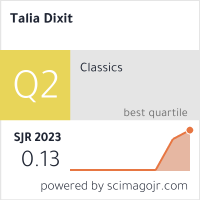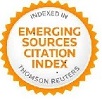Edición y traducción del discurso Oratores ante poetas esse a pueris cognoscendos (1552) de Juan Sambuco
DOI:
https://doi.org/10.17398/Palabras clave:
Juan Sambuco, Johannes Sambucus, retórica, oratoria, poesía, escuela, discurso escolarResumen
Edición y traducción del discurso Oratores ante poetas esse a pueris cognoscendos, pronunciado por el humanista húngaro Johannes Sambucus (János Zsámboki, 1531-1584) en la Universidad de la Sorbona de París en septiembre de 1551 y publicado un año después en Basilea, como apéndice a sus Δηµηγορίαι, hoc est, conciones aliquot ex libris Xenophontis de Paedia Cyri, una antología de discursos extraídos de la Ciropedia destinada a los estudiantes de la lengua griega en general y de oratoria en particular. La edición y traducción del texto latino viene precedida de un pequeño estudio introductorio en el que se bosqueja una breve semblanza del autor y su obra y se especifican las características fundamentales del discurso en cuestión.
Descargas
Referencias
ALONSO GUARDO, A (2008), “Emblemática y Medicina. Descripción y comentario del Emblema de Juan Sambuco titulado Partes hominis”, Humanistica Lovaniensia. Journal of Neo-Latin Studies 57: 167-184.
ALMÁSI, G. (2009), The Uses of Humanism: Johannes Sambucus (1531-1584), Andreas Dudith (1533-1589) and the Republic of Letters in East Central Europe, Leiden-Boston: Brill.
ALMÁSI, G. et alii (eds.) (2014), A Divided Hungary in Europe: Exchanges, Networks and Representations, 1541-1699. Volume 1. Study Tours and Intellectual-Religious Relationships, Newcastle upon Tyne: Cambridge Scholars Publishing.
ALMÁSI, G. & KISS, F. G. (2014), Humanistes du bassin des Carpates, vol. 2: Johannes Sambucus [Europa Humanistica, vol. 14], Turnhout: Brepols.
BAKEWELL, S. (1994), A bibliography of Joannes Sambucus (1531–1584), Submitted in part requirement for the degree of M.A. of University College, London, Dept. of Library, Archive and Information Studies, September 1994.
GASTGEBER, Ch. & KLECKER, E. (eds.) (2017), Iohannes Sambucus / János Zsámboki / Ján Sambucus (1531-1584): Philologe, Sammler und Historiograph am Habsburgerhof, Wien: Praesens Verlag.
GERSTINGER, H. (ed.) (1965), From the diary of the imperial court historian Johannes Sambucus (1531–1584): Cod Vind Latin 9039, fol (Proceedings of the Austrian Academy of Sciences of Humanities Class, Volume 248, 2 Dep.). Vienna: Böhlau.
GERSTINGER. H. (1968), Die Briefe des Johannes Sambucus (Zsamboky) 1554-1584. Mit einem Anhang: die Zambucusbriefe im Kreisarchiv von Trnava von Anton Vantuck, us (Zsamboky) 1554-1584, Wien: Böhlau.
IGLESIAS-ZOIDO, J. C. & PINEDA, V. (eds.) (2017), Anthologies of Historiographical Speeches from Antiquity to Early Modern Times. Rearranging the Tesserae, Leiden- Boston: Brill.
LÓPEZ-PELÁEZ CASELLAS, Mª P. (2006), “Dos extrañas representaciones del músico Orfeo en la emblemática renacentista y barroca”, Laboratorio de Arte 19: 131-142.
LÓPEZ-PELÁEZ CASELLAS, Mª P. (2008), Mª P. “Orfeo como símbolo de la elocuencia y la civilización. Un estudio desde la emblemática”, Cuad. Art. Gr. 39: 285-299.
MARSH, D. (1984), “Lorenzo Valla in Naples: The Translation from Xenophon's
Cyropaedia”, Bibliotheque d'humanisme et Renaissance 46: 407-420.
MARSH, D. (1992), “Xenophon”, in V. Brown, P.O. Kristeller and F.E. Cranz, eds., Catalogus translationum et commentariorum, vol. 7, Washington: The Catholic University of America Press, pp. 75-196.
MONFASANI, J. (1976), George of Trebizond: A Biography and a Study of His Rhetoric and Logic, Leiden-Boston: Brill.
TINSLEY, B. S. (1989), “Johann Sturm’s Method for Humanistic Pedagogy”, The Sixteenth Century Journal 20.1: 23-40.
VISSER, A. S. Q. (2005), Joannes Sambucus and the learned image: The Use of the Emblem in Late-Renaissance Humanism, Brill’s Studies in Intellectual History 128, Leiden- Boston: Brill.
VISSER, A. S. Q. (2007), “Icons of the past: Joannes Sambucus and the medical republic of letters”, Ars 40: 19-30.
WEINBERG, B. (2002), “Demetrius Phalereus”, in P.O. Kristeller and F.E. Cranz, eds., Catalogus translationum et commentariorum, vol. 2, Washington: The Catholic University of America Press, pp. 36-37.
Publicado
Versiones
- 2024-11-04 (2)
- 2018-10-01 (1)













